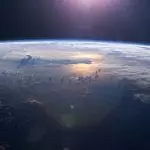[Originally published as Air]
Have you ever considered the many amazing properties of air and what earth would be like if these properties were significantly different?
According to the Oxford Dictionary of Science, the gas that surrounds the earth (dry air at sea level) is
- 78.08% nitrogen,
- 20.95% oxygen,
- 0.93% argon,
- 0.03% carbon dioxide,
- 0.0018% neon,
- 0.0005% helium,
- 0.0001% krypton,
- and 0.00001% xenon.
So, as most people are aware, air is made up of over 99% nitrogen and oxygen.
With oxygen composing about 21% of air, the concentration is sufficient to allow for human and animal breathing. Breathing air with a higher percentage of oxygen can be invigorating but makes rapid oxidation a risk.
Oxidation occurs when an element unites with oxygen, for example causing rusting or burning. People who need to breathe pure oxygen know the great risk of fire and must warn others about keeping open flames far away. If air had a higher percentage of oxygen one can only imagine the constant danger of wildfires.
Air has a number of other wonderful properties we often take for granted, such as:
- Air molecules provide pressure that holds things in life together. For example, air pressure keeps our skin and tissues taut against our internal organs and bones.
- Air is the earth’s insulator against the temperature extremes of space. Compared to the moon, for example, temperature extremes are much smaller due to this thermal insulation. The moon has no atmosphere, so when the sun shines on the moon its surface temperature rises up to 250° F. When there is no sunshine on the moon’s surface, its temperature drops to minus 400° F!
- Air is odorless. This allows us to sense good and bad smells. We can smell perfumes, rotten eggs, and everything in between because of this property of air. God engineered the air, other gases, and our noses so as to work in harmony to our benefit.
- Air is colorless. Just consider the problems colored air could cause our vision. Yet we can see the blue sky, sunrises and sunsets, clouds, and much more because of this unique property. The moon has no air and thus its sky is always dark.
- The mixture of gases in air allows life to exist here on earth. For example, carbon dioxide is used by plants for photosynthesis and nitrogen is needed for plant cell growth.
- The atmosphere acts to prevent much of the sun’s harmful ultraviolet radiation from reaching the surface where we live.
The Bible tells us that Jesus Christ is the Creator of all these properties of air and that He holds all things together:
He is the image of the invisible God, the firstborn over all creation. For by him all things were created: things in heaven and on earth, visible and invisible, whether thrones or powers or rulers or authorities; all things were created by him and for him. He is before all things, and in him all things hold together. And he is the head of the body, the church; he is the beginning and the firstborn from among the dead, so that in everything he might have supremacy. For God was pleased to have all his fullness dwell in him, and through him to reconcile to himself all things, whether things on earth or things in heaven. ~Colossians 1:14-20 NIV
Glory be to the Creator!






